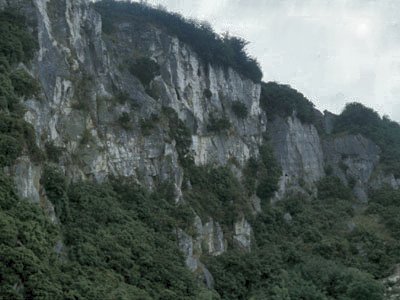Earth Science Conservation Review
| Creggan Quarry | Antrim |
| Site Type: | Quarry (disused) |
| Site Status: | ESCR |
| Council area: | Larne Borough Council |
| Grid Reference: | D277187 |
| Google maps: | 54.99982,-6.00442 |
| Rocks | |
|---|---|
| Rock Age: | Cretaceous (Campanian) |
| Rock Name: | Creggan Chalk Member, Ulster White Limestone Formation |
| Rock Type: | Flint, Limestone |
| Interest | |
| Fossil Groups: | Belemnite, Echinoderm |
| Other interest: | Marine sediments, hardground |
Summary of site:
The Ulster White Limestone was deposited as a white ooze on a moderately deep seabed at the end of the Cretaceous period, between 85 and 65 million years ago (the closing years of the Age of the Dinosaurs). It is represented by over 133m of rock in total thickness, most of it very similar beds (to the untutored eye) of chalk with flints. It has been divided into 14 units and it follows that these are difficult to recognise in rocks of such similar appearance. Detailed descriptions are therefore of vital importance and that is the significance of this site which defines the Creggan Chalk Member of the Ulster White Limestone and is its type locality.
The face of this disused quarry exposes the full thickness of the Creggan Chalk which is about 3.45m here. The member immediately beneath it, and which it succeeds without a break in time, is the Cloghnastucan Chalk, well exposed here. The member immediately above, separated by a significant period of time, is the Boheeshane Chalk, also clearly exposed in the quarry.
The base of the Creggan Chalk is a thin limestone full of Inoceramus fragments. Inoceramus was a marine bivalve mollusc with a thick prismatic shell that fragmented readily into small but recognisable pieces. Such fragments occur at many levels in the Ulster White Limestone but the basal bed of the Creggan Chalk has an unusually high concentration amounting to around 20% by volume, making recognition easy. The rest of the member consists of chalk with some levels rich in green-stained pebbles. These beds seem to be hardgrounds, i.e. patches of chalk ooze immediately below the seabed of the time that cemented quickly to hard rock. Hardgrounds tend to coalesce into continuous layers and several can be seen in the quarry. One such horizon, with rolled belemnites and sea urchin tests replaced with flint, marks the top of the member. Small flints, mostly showing the form of the burrows they have replaced, are scattered through the member.
Ulster White Limestone sedimentation is complicated, starting at different times in different places, often omitting lower members of the sequence. A prominent ridge of high ground, creating two basins for the first part of this time, is a further complication. For a discussion of all these factors read the account for Key Site 1211 ‘Capecastle Quarry'.
This site characterises the Creggan Chalk Member, defining its limits and relationships to adjacent members and is essential to our understanding of the Ulster White Limestone. It is nationally important and should be designated as an Area of Special Scientific Interest and afforded full protection.
The face of this disused quarry exposes the full thickness of the Creggan Chalk which is about 3.45m here. The member immediately beneath it, and which it succeeds without a break in time, is the Cloghnastucan Chalk, well exposed here. The member immediately above, separated by a significant period of time, is the Boheeshane Chalk, also clearly exposed in the quarry.
The base of the Creggan Chalk is a thin limestone full of Inoceramus fragments. Inoceramus was a marine bivalve mollusc with a thick prismatic shell that fragmented readily into small but recognisable pieces. Such fragments occur at many levels in the Ulster White Limestone but the basal bed of the Creggan Chalk has an unusually high concentration amounting to around 20% by volume, making recognition easy. The rest of the member consists of chalk with some levels rich in green-stained pebbles. These beds seem to be hardgrounds, i.e. patches of chalk ooze immediately below the seabed of the time that cemented quickly to hard rock. Hardgrounds tend to coalesce into continuous layers and several can be seen in the quarry. One such horizon, with rolled belemnites and sea urchin tests replaced with flint, marks the top of the member. Small flints, mostly showing the form of the burrows they have replaced, are scattered through the member.
Ulster White Limestone sedimentation is complicated, starting at different times in different places, often omitting lower members of the sequence. A prominent ridge of high ground, creating two basins for the first part of this time, is a further complication. For a discussion of all these factors read the account for Key Site 1211 ‘Capecastle Quarry'.
This site characterises the Creggan Chalk Member, defining its limits and relationships to adjacent members and is essential to our understanding of the Ulster White Limestone. It is nationally important and should be designated as an Area of Special Scientific Interest and afforded full protection.
| Enlander, I., Dempster, M. & Doughty, P., 2025. Creggan Quarry, County Antrim, site summary. [In] Earth Science Conservation Review. https://www.habitas.org.uk/escr/summary.php?item=1214. Accessed on 2025-04-03 |
| Previous Site | Next Site |
